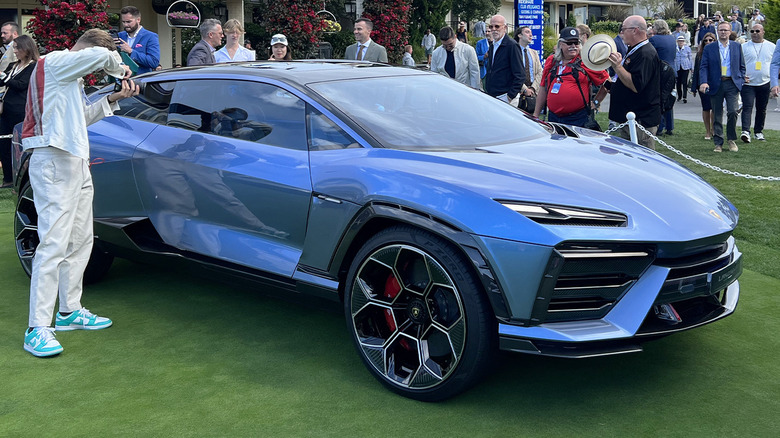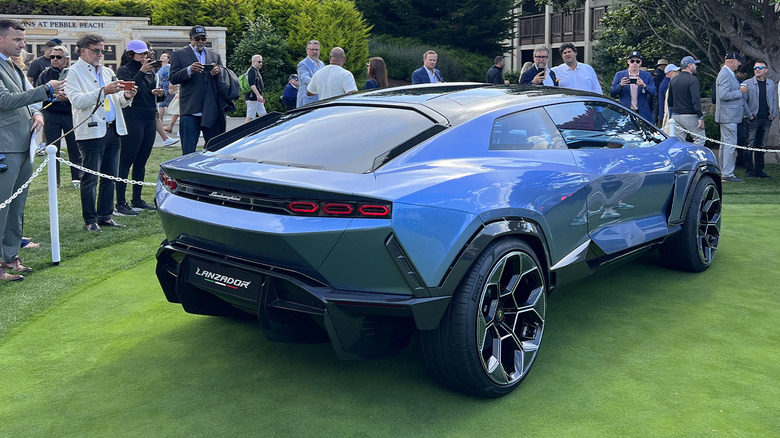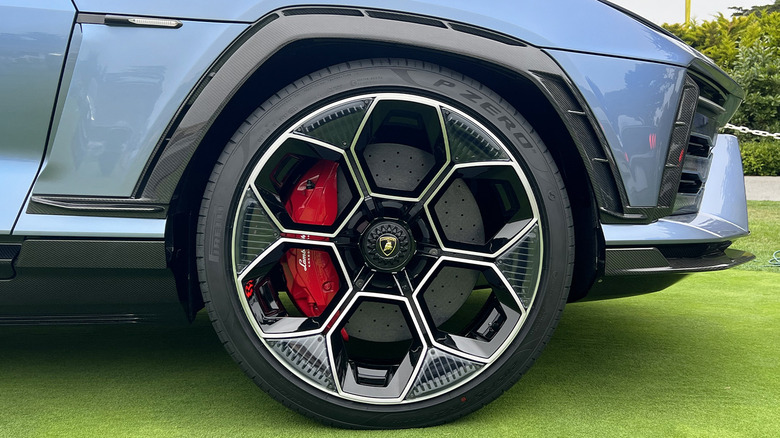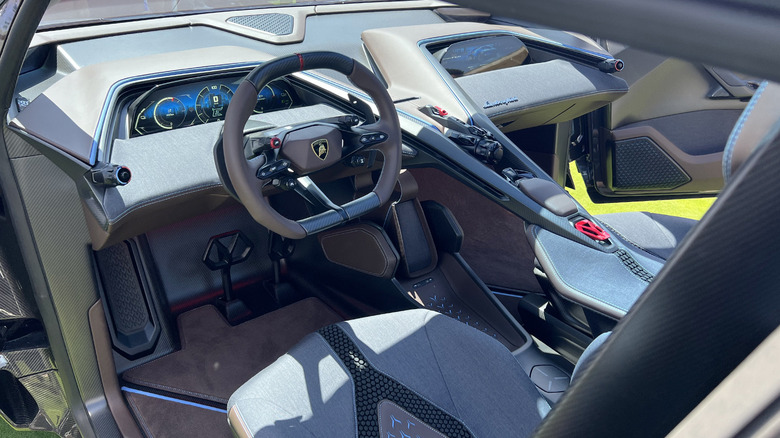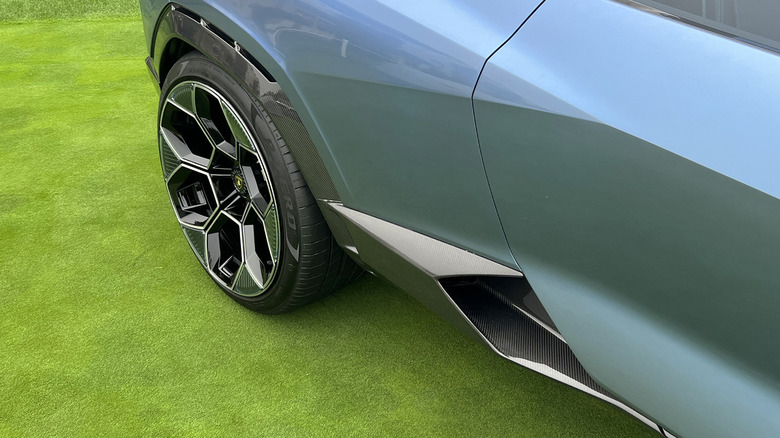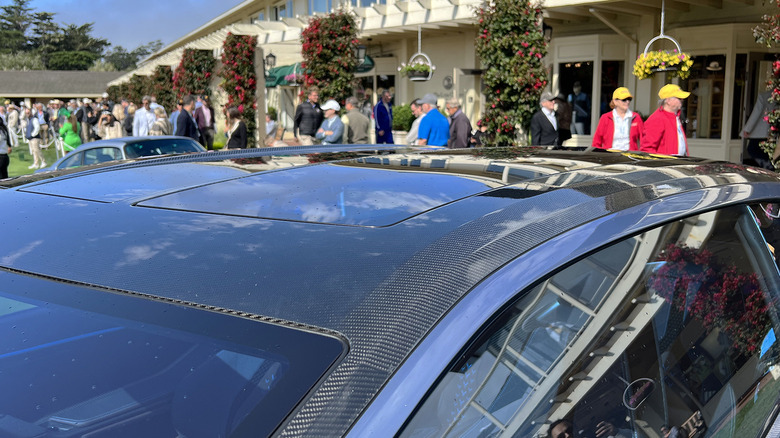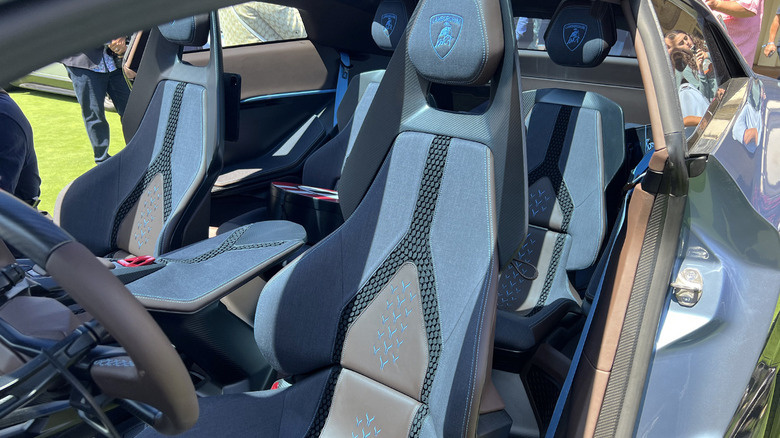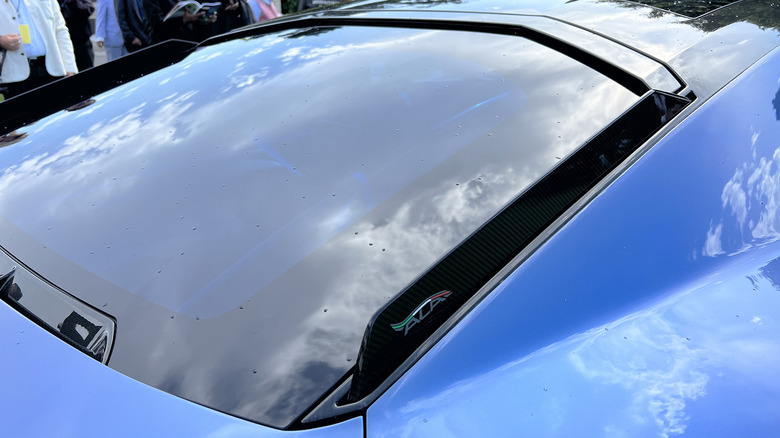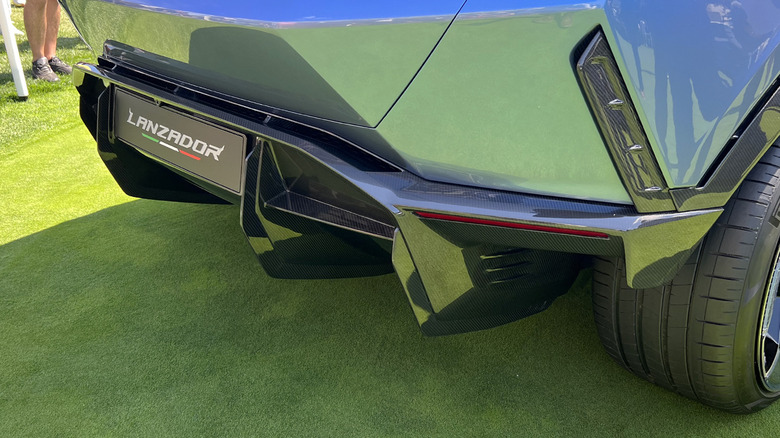We Quizzed Lamborghini's Tech Chief On How The Lanzador Concept Can Help Make EVs Fun
This past Friday at The Quail, A Motorsports Gathering, Lamborghini unveiled an all-electric concept car dubbed "Lanzador" with promises that a production version will debut by 2028. With a decidedly futuristic aesthetic that blurs the lines between supercar and electric commuter, the Lanzador drew big crowds for its official reveal, while also causing plenty of controversy online.
Up close and in person at the Quail stage, the Lanzador looks leaner and meaner than perhaps many of the press photos represented. On Sunday at the Pebble Beach Concours d'Elegance Concept Lawn, I spoke with Lamborghini Chief Technical Officer Rouven Mohr to learn more about the challenges of pivoting to electric power while maintaining the engaging emotionality that Lamborghini aims to embody with every car, truck, and SUV.
A running, driving concept car
The Lanzador's aesthetic marks a clear shift for Lambo after the first two decades of this millennium focusing mainly on true supercars: first the Gallardo and Murcielago, then the Aventador in 2011, and for 2014, the Huracan. The automaker even described the design as first of an "Ultra GT" class, its images showing a car that looked far less radical (and perhaps closer to a true production model) than the average concept released half a decade in advance. Yet Mohr assured me that the styling of this running and driving concept car—not yet equipped with the full powertrain but still built out of real materials rather than clay or Plasticine—will largely carry over to the eventual production model.
"The project has already started since one and half years," said Mohr. "It's not the kind of fantasy of what we can do, what we can show. The real car is already on the way and I can also say that the real car is very close to the show car."
Mohr referenced the original Urus concept that debuted in 2012, saying the Lanzador already looks more similar to its current production version than the Urus, which changed radically by the time production began for model year 2018 as part of a shared project with Volkswagen AG (immediately becoming the company's best-selling model ever). Now, with the Urus scheduled to transition to hybrid power for model year 2024 and, eventually, full electric power, I wondered how Lamborghini can differentiate the two-door Lanzador from that true SUV.
"What we will not do," Mohr replied, "Is to completely reposition the Urus, because the Urus is a success story and exactly fits the size and the proportions that people love."
Instead, Lanzador aims to find a middle ground that only the packaging of electric powertrain components can allow.
Advantages to electric powertrain configurations
"We want to offer something that is for people that are looking really for a supercar's shape, but that want to have more space," Mohr explained. "The people that want to be dressed a little bit more elegant, if they go in the city center or the opera. So this is an additional offering that we say is in-between the super sports car client and the Urus client, something exactly in-between the bandwidth of comfortable driving. Also, this is much easier, because you can decide to switch off to have this completely silent route."
Compact electric motors and a skateboard chassis create the kind of interior space those customers want, Lamborghini believes, combined with a lifted ride height that caters to the urban SUV buyer. But within the Lanzador's angular and muscular design, Mohr believes the spirit of a supercar still shines through.
"The package of this car is only possible with a full electric," he told me. "If you want to build this car with a sufficiently big combustion engine, it's not possible because you need a front-mounted engine. In the Huracan it's possible, but the engine's in the back."
I asked whether Lambo planned to retain the by-now-de-rigeuer skateboard battery layout, or if new technology on the horizon might allow for a change to a dogbone or spine configuration.
"It's an elevated car, so this car will have a more skateboard technology," Mohr said, "But even if it's skateboard, it's not a classical one. We worked a lot on the height of the skateboard because the sitting position compared to the floor has to be as low as in a supercar."
A supercar cockpit in an EV chassis
Mohr then walked me over to check out the Lanzador interior, opening the two long doors and pointing out the dash, steering wheel, and seating arrangements in the grand touring 2+2 cockpit.
"The angle of the steering wheel, the sitting position compared to the floor of the car, it's exactly like in a supercar. So you have the feeling you're sitting in a supercar, just higher up."
I noted the distinct lack of massive touchscreens that so many manufacturers install in halo EVs these days. Instead, the Lanzador's dash forms a sort of Y from the center console to two panoramic screens, one ahead of each front seat.
"We have the latest technologies but a little bit more, let me say, more elegant shaped," Mohr agreed. "And in this concept car, the screens are even moving, so you can see they are like pop-up headlights. They are a little bit inspired by the Countach."
Don't worry, I pointed out, the fighter-jet starter button carries over from the current Aventador, Huracan, and Urus. Mohr laughed.
"We are brand that wants to have this pilot feeling," he continued, "we are not producing a kind of television on four wheels, we are producing a driver's car or a driver and copilot car."
Finding the right balance for EV fun
Creating an EV that can carry on Lamborghini's legacy requires more than simply building cars with powerful acceleration and aggressive styling. In fact, Mohr explained how much science goes into the little details that make a car produce that jet-fighter pilot sensation.
"It's not really so much the hardware," he said, "it's more how you make the orchestra of all the components to bring the soul into the car. Because at the moment, a lot of electric cars are suffering, they're missing the soul because you're jumping in and everything is nice, the cars are fast, everything is cool. You can switch on sound, you can do what you want, but it's not really touching you."
Modern driving simulators and a history building supercars lends Mohr the confidence to say that the Lanzador will deliver "a driving feeling that you have never experienced before." Extensive carbon fiber construction, including a claimed manufacturing technique that recycles carbon fibers, helps to keep weight down. But harnessing the more discretely adjustable characteristics of electric motors will go a long way towards that goal, too.
"On the driving simulator, we really can measure physical reaction of the body related to emotions," Mohr revealed. "And we did a huge study in, for instance, acceleration shapes. What is the reaction of the shape of the lateral acceleration when you turn? What is generating these emotions? The Huracan is a car that is catching you like this, but it's not by chance."
"We see a huge potential, not so much for torque vectoring which is also available today, but in the precision of how you can control the wheel, especially in the transition from grip to slip and what you can do with the wheel. If the wheel is slipping, this opens the door to a new drive that's also not possible with a combustion car."
Stepping towards a sustainable supercar future
That performance potential can hopefully help comfort those bemoaning the lack of a gas V12 or the fact that the Lanzador can (maybe somewhat fairly) be described as yet another electric crossover. Mohr acknowledges the critics, but believes that finding the additional value inherent in new powertrain technologies will bridge the gap for anyone who actually gets behind the wheel.
"Our philosophy is not how we can try to imitate, as best as we can, the best combustion car," he assured me. "You will be always the second best, so our philosophy is understanding what is generating today's emotions, carrying over this DNA, and adding an additional value that the electric drivetrain is putting there."
Lamborghini's Urus blends the characteristics of a family commuter with supercar aspirations, which entirely transformed the brand's approachability and exotic appeal. The Lanzador goes a step further into the era that execs call "Direzione Cor Tauri," as an homage to the northstar of truly sustainable automaking.
These sustainability efforts, as mandated to at least some extent by government regulations, might seem like positioning from the outside, but regardless, the electric era undoubtedly looms just around the corner. Mohr believes that Lamborghini's position within Volkswagen AG can help speed up the successful integration of electrification into the company's lineup.
"We are part of the Volkswagen network," Mohr said. "So we have also a huge exchange between the brands and for sure, we know what to do a little bit more. This is a strength of the group, definitively. It's not only sharing parts, it's also sharing the knowledge, sharing the lessons learned, building up a network, earning from each other, and challenging each other. Because at the end of the day, on the market, we are still competitors."
Competition within and without Volkswagen AG
I asked just how much involvement Lamborghini might accept from the electric car whizzes at Rimac (and now Bugatti) or even Porsche, but Mohr remained deliberately vague.
"We have really a strong future in front of us in the group," he hedged, "because we are launching a lot of electric platforms that are really high performing. So on this, to be honest, I see a huge advantage compared to some of our core competitors."
Will the Lanzador introduce something as-yet unseen on the Rimac or Taycan, possibly new battery and motor technology make a giant leap between now and 2028? Again, Mohr skirted the question without revealing too much about internal plans.
"The evolution of technology will continue permanently," he replied. "In the BEV segment, we are ... at the very beginning. Performance is always a baseline, but I want to add something, the main working point on this car is also on the driving experience."
"I'm a guy that loves to drive cars," Mohr laughed. "And at the moment there is no offer on the market, on the full electric side, where I say it's fitting to our Lamborghini brand DNA. Therefore, we will spend a lot of effort, especially, on this driving thrill that we want to have to demonstrate that we are able to bring a full electric car on the market."
Active aerodynamics and suspension are especially crucial for EVs
Mohr willingly discussed the aerodynamics and suspension that Lamborghini knows will make a huge difference for both the Lanzador's electric range and driving dynamics. The overall goal involves using successful tuning of the active aero and air suspension to balance efficiency and downforce as needed.
Even on the Lanzador concept, a front splitter can move forward, active flaps help with brake cooling, louvers under the wheel arches reduce pressure, and a venturi effect under the car feeds an electrically adjustable rear diffuser that pairs with a small ducktail to balance downforce effectively. Meanwhile, passive stacks under the hood and fins on each side of the rear decklid glass contribute to the overall system.
But Mohr wanted to make sure I knew the Lanzador is not, in any way, what we might think of as an "aero car" from other manufacturers (he didn't mention, but I immediately thought of, the new 992-generation Porsche 911 GT3 RS with its massive wing and DRS system).
"The car is not telling you, 'Hello, I'm an aero car, I have a wing, I have moved the wing!'" Mohr joked. "This is more elegant, should be more elegant ... We don't want to change our basic design language only because it's full electric."
The air suspension system, meanwhile, will adjust ride height to optimize aerodynamics at speed—for both range while commuting and spirited driving—but also needs to allow for a smooth ride as in the Urus when all the settings are toned down during daily driving.
"The real car will, for sure, have an air suspension system," Mohr said. "The latest, best technology that you can have from an air suspension point of view. We chose an air suspension because the comfort requirements of this car have to be higher. It's still a car that you use for traveling and also that you use for relaxed driving. In this context, there is no better option than an air suspension."
Will we rally the Lanzador?
Lamborghini introduced the Lanzador at The Quail parked on a stage directly next to the safari-style Huracan Sterrato, creating a perfect picture of the divergence emerging in today's automotive industry. On one side, a celebration of internal-combustion's last gasp that takes driving fun to the next level with a naturally aspirated V10, knobby tires, fender flares, and a roof rack on a chassis formerly reserved exclusively for lowslung, taut supercars.
Now the new Lanzador attempts to bring that level of fun to the electric landscape. But fully aware of my obsession with rally racing (both Mohr and I own Mitsubishi Evolutions) and how much I enjoyed blasting the Huracan Sterrato around a dirt rallycross circuit at Chuckwalla Raceway earlier this year, Mohr must have known my next question was coming a long way off: will we rally it?
"Right now, we are focusing on the base car," he replied with a grin, "But you can be sure, like always, we are already thinking also about lifecycle, so you can be excited about what is coming next."
Will I miss that screaming V10 blattering sideways through dirt drifts? Of course. But a high-performance EV with lifted suspension, active aerodynamics, almost infinitely programmable tire control... Having driven the Rimac Nevera, the Lucid Air Sapphire, and even off-roaded a Jeep in all-electric mode, the Lanzador seems ripe for a Sterrato treatment to my eyes. For Mohr, as the chief technology officer at Lamborghini, the potential for fun with electric cars adds a new level of excitement to the automotive landscape.
"Sometimes I call it not electrification," he says. "In some cases, it's also amplification."
